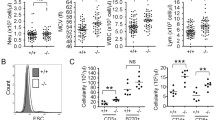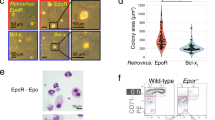Abstract
In anuran amphibians, larval red blood cells (RBCs) are replaced by adult-type RBCs during metamorphosis. We previously showed that tumor necrosis factor-related apoptosis-inducing ligand 1 (TRAIL1) induces apoptosis in larval-, but not adult-type RBCs in Xenopus laevis. We also found that protein kinase C (PKC) activation is involved in establishing resistance to TRAIL1-induced apoptosis in adult-type RBCs. Here, we investigated whether erythropoietin (EPO), which induces PKC activation in mammalian erythroblasts, is involved in the RBC transition in X. laevis. RT-PCR analysis revealed that epo mRNA was upregulated in the lung, from the metamorphic climax (stage 60) onward. In an RBC culture system, EPO pretreatment significantly attenuated the TRAIL1-induced death of larval- and adult-type RBCs isolated from tadpoles and adults, probably due partly to PKC activation. In samples from froglets undergoing RBC transition, which included both larval- and adult-type RBCs, EPO exhibited a stronger protective effect on the adult-type than the larval-type RBCs. Newly differentiated RBCs isolated from tadpoles treated with a hemolytic reagent were more resistant to TRAIL1-induced cell death than non-treated controls. These results suggest that EPO functions to protect adult-type RBCs from TRAIL1-induced cell death during RBC transition, and that the protective effect might decrease as RBCs age.






Similar content being viewed by others
Abbreviations
- RBC:
-
Red blood cell
- EPO:
-
Erythropoietin
- TRAIL:
-
Tumor necrosis factor-related apoptosis-inducing ligand
- PKC:
-
Protein kinase C
References
Wiley SR, Schooley K, Smolak PJ, Din WS, Huang CP, Nicholl JK, Sutherland GR, Smith TD, Rauch C, Smith CA, Goodwin RG (1995) Identification and characterization of a new member of the TNF family that induces apoptosis. Immunity 3:673–682
Pitti RM, Marsters SA, Ruppert S, Donahue CJ, Moore A, Ashkenazi A (1996) Induction of apoptosis by Apo-2 ligand, a new member of the tumor necrosis factor cytokine family. J Biol Chem 271:12687–12690
Kischkel FC, Lawrence DA, Chuntharapai A, Schow P, Kim KJ, Ashkenazi A (2000) Apo2L/TRAIL-dependent recruitment of endogenous FADD and caspase-8 to death receptors 4 and 5. Immunity 12:611–620
Sprick MR, Weigand MA, Rieser E, Rauch CT, Juo P, Blenis J, Krammer PH, Walczak H (2000) FADD/MORT1 and caspase-8 are recruited to TRAIL receptors 1 and 2 and are essential for apoptosis mediated by TRAIL receptor 2. Immunity 12:599–609
Seol DW, Li J, Seol MH, Park SY, Talanian RV, Billiar TR (2001) Signaling events triggered by tumor necrosis factor-related apoptosis-inducing ligand (TRAIL): caspase-8 is required for TRAIL-induced apoptosis. Cancer Res 61:1138–1143
Mirandola P, Gobbi G, Ponti C, Sponzilli I, Cocco L, Vitale M (2006) PKC epsilon controls protection against TRAIL in erythroid progenitors. Blood 107:508–513. doi:10.1182/blood-2005-07-2676
Witthuhn BA, Quelle FW, Silvennoinen O, Yi T, Tang B, Miura O, Ihle JN (1993) JAK2 associates with the erythropoietin receptor and is tyrosine phosphorylated and activated following stimulation with erythropoietin. Cell 74:227–236
Huang LJ, Constantinescu SN, Lodish HF (2001) The N-terminal domain of Janus kinase 2 is required for Golgi processing and cell surface expression of erythropoietin receptor. Mol Cell 8:1327–1338
Baker SJ, Rane SG, Reddy EP (2007) Hematopoietic cytokine receptor signaling. Oncogene 26:6724–6737. doi:10.1038/sj.onc.1210757
Silva M, Benito A, Sanz C, Prosper F, Ekhterae D, Nuñez G, Fernandez-Luna JL (1999) Erythropoietin can induce the expression of bcl-x(L) through Stat5 in erythropoietin-dependent progenitor cell lines. J Biol Chem 274:22165–22169
Mori M, Uchida M, Watanabe T, Kirito K, Hatake K, Ozawa K, Komatsu N (2003) Activation of extracellular signal-regulated kinases ERK1 and ERK2 induces Bcl-xL up-regulation via inhibition of caspase activities in erythropoietin signaling. J Cell Physiol 195:290–297. doi:10.1002/jcp.10245
von Lindern M, Parren-van Amelsvoort M, van Dijk T, Deiner E, van den Akker E, van Emst-de Vries S, Willems P, Beug H, Löwenberg B (2000) Protein kinase C alpha controls erythropoietin receptor signaling. J Biol Chem 275:34719–34727. doi:10.1074/jbc.M007042200
Richmond TD, Chohan M, Barber DL (2005) Turning cells red: signal transduction mediated by erythropoietin. Trends Cell Biol 15:146–155. doi:10.1016/j.tcb.2005.01.007
Socolovsky M, Fallon AE, Wang S, Brugnara C, Lodish HF (1999) Fetal anemia and apoptosis of red cell progenitors in Stat5a-/-5b-/- mice: a direct role for Stat5 in Bcl-X(L) induction. Cell 98:181–191
Ribeil JA, Zermati Y, Vandekerckhove J, Cathelin S, Kersual J, Dussiot M, Coulon S, Moura IC, Zeuner A, Kirkegaard-Sorensen T, Varet B, Solary E, Garrido C, Hermine O (2007) Hsp70 regulates erythropoiesis by preventing caspase-3-mediated cleavage of GATA-1. Nature 445:102–105. doi:10.1038/nature05378
Nishikawa A, Hayashi H (1999) T-3-hydrocortisone synergism on adult-type erythroblast proliferation and T-3-mediated apoptosis of larval-type erythroblasts during erythropoietic conversion in Xenopus laevis. Histochem Cell Biol 111:325–334
Tamura K, Mawaribuchi S, Yoshimoto S, Shiba T, Takamatsu N, Ito M (2010) Tumor necrosis factor-related apoptosis-inducing ligand 1 (TRAIL1) enhances the transition of red blood cells from the larval to adult type during metamorphosis in Xenopus. Blood 115:850–859. doi:10.1182/blood-2009-04-218966
Haslauer M, Baltensperger K, Porzig H (1999) Erythropoietin- and stem cell factor-induced DNA synthesis in normal human erythroid progenitor cells requires activation of protein kinase Calpha and is strongly inhibited by thrombin. Blood 94:114–126
Myklebust JH, Smeland EB, Josefsen D, Sioud M (2000) Protein kinase C-alpha isoform is involved in erythropoietin-induced erythroid differentiation of CD34(+) progenitor cells from human bone marrow. Blood 95:510–518
Nogawa-Kosaka N, Hirose T, Kosaka N, Aizawa Y, Nagasawa K, Uehara N, Miyazaki H, Komatsu N, Kato T (2010) Structural and biological properties of erythropoietin in Xenopus laevis. Exp Hematol 38:363–372. doi:10.1016/j.exphem.2010.02.009
Nogawa-Kosaka N, Sugai T, Nagasawa K, Tanizaki Y, Meguro M, Aizawa Y, Maekawa S, Adachi M, Kuroki R, Kato T (2011) Identification of erythroid progenitors induced by erythropoietic activity in Xenopus laevis. J Exp Biol 214:921–927. doi:10.1242/jeb.050286
Wickrema A, Bondurant MC, Krantz SB (1991) Abundance and stability of erythropoietin receptor mRNA in mouse erythroid progenitor cells. Blood 78:2269–2275
Aizawa Y, Nogawa N, Kosaka N, Maeda Y, Watanabe T, Miyazaki H, Kato T (2005) Expression of erythropoietin receptor-like molecule in Xenopus laevis and erythrocytopenia upon administration of its recombinant soluble form. J Biochem 138:167–175. doi:10.1093/jb/mvi113
Alfrey CP, Rice L, Udden MM, Driscoll TB (1997) Neocytolysis: physiological down-regulator of red-cell mass. Lancet 349:1389–1390. doi:10.1016/S0140-6736(96)09208-2
Rice L, Alfrey CP (2005) The negative regulation of red cell mass by neocytolysis: physiologic and pathophysiologic manifestations. Cell Physiol Biochem 15:245–250. doi:10.1159/000087234
Rice L, Ruiz W, Driscoll T, Whitley CE, Tapia R, Hachey DL, Gonzales GF, Alfrey CP (2001) Neocytolysis on descent from altitude: a newly recognized mechanism for the control of red cell mass. Ann Intern Med 134:652–656
Risso A, Turello M, Biffoni F, Antonutto G (2007) Red blood cell senescence and neocytolysis in humans after high altitude acclimatization. Blood Cells Mol Dis 38:83–92. doi:10.1016/j.bcmd.2006.10.161
Rice L, Alfrey CP, Driscoll T, Whitley CE, Hachey DL, Suki W (1999) Neocytolysis contributes to the anemia of renal disease. Am J Kidney Dis 33:59–62
Yang CW, Li C, Jung JY, Shin SJ, Choi BS, Lim SW, Sun BK, Kim YS, Kim J, Chang YS, Bang BK (2003) Preconditioning with erythropoietin protects against subsequent ischemia-reperfusion injury in rat kidney. FASEB J 17:1754–1755. doi:10.1096/fj.02-1191fje
Acknowledgments
This work was supported in part by a Grant-in-Aid for Scientific Research from the Ministry of Education Culture, Sports, Science, and Technology (M. I.), Kitasato University Research Grant for Young Researchers (K. T.).
Conflict of interest
The authors declare no competing financial interests.
Author information
Authors and Affiliations
Corresponding author
Rights and permissions
About this article
Cite this article
Tamura, K., Takamatsu, N. & Ito, M. Erythropoietin protects red blood cells from TRAIL1-induced cell death during red blood cell transition in Xenopus laevis . Mol Cell Biochem 398, 73–81 (2015). https://doi.org/10.1007/s11010-014-2206-0
Received:
Accepted:
Published:
Issue Date:
DOI: https://doi.org/10.1007/s11010-014-2206-0




